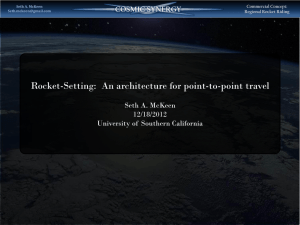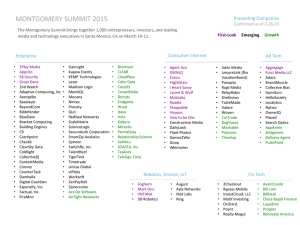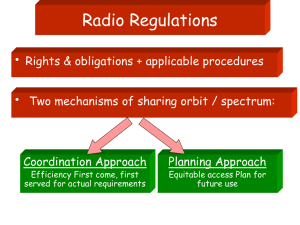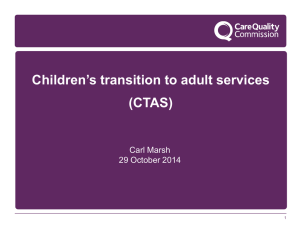Global Jumper
advertisement
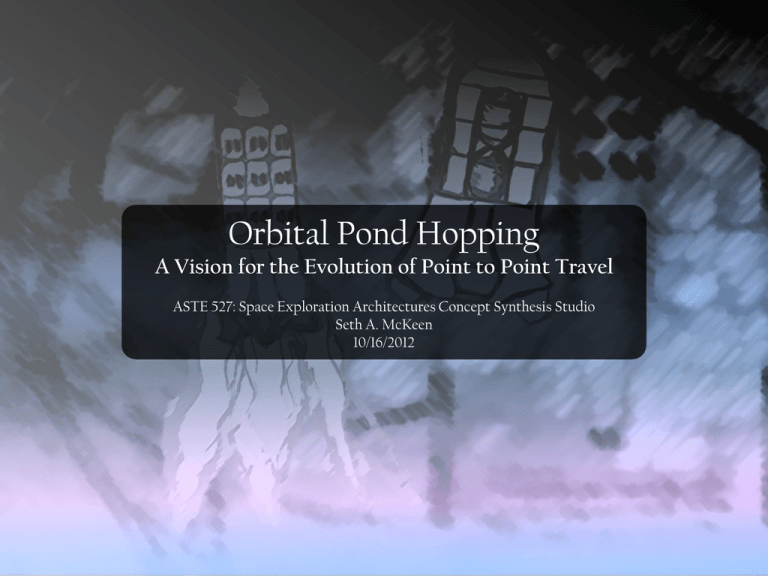
Orbital Pond Hopping A Vision for the Evolution of Point to Point Travel ASTE 527: Space Exploration Architectures Concept Synthesis Studio Seth A. McKeen 10/16/2012 Orbital Pond Hopping: A Vision for the Evolution of Point-to-Point Travel Seth A. McKeen | seth.mckeen@gmail.com Potential Implications of Point to Point Travel World wide network of Ultrafast Point to Point Travel. Huge networks of global hubs, all reachable within an hour or so. Goal of the architecture: get ~ 50 essentially anywhere in the world in less than an hour. *Transit times are back of the envelope Orbital Pond Hopping: A Vision for the Evolution of Point-to-Point Travel Global Jumper: 48 Passenger Orbital Jumpcraft; Used for commercial travel from city to fuel depot to city. Vertical Take off, vertical landing (VTVL), fully and rapidly reusable. Seth A. McKeen | seth.mckeen@gmail.com Passenger deck Custom Lightweight, Reclining Seats Top view of a typical passenger Deck on a Global Jumper Los Angeles Air & Space Port One of many potential evolved airports that could be upgraded with P-P / Space Tourism Concourses once the market is booming. Orbital Pond Hopping: A Vision for the Evolution of Point-to-Point Travel Simplified landing model shows only ~3.5% of the touchdown weight of the Booster’s worth of propellant is needed for soft landing for full reusability. Seth A. McKeen | seth.mckeen@gmail.com Alt: 50 KM (160,000 FT.) First Stage Separates and Boosts Back to Los Angeles for refueling and reuse. Alt: 150 KM (500,000 FT.) In Low Earth Orbit, ΔV ~ 9200 m/s complete. Rendezvous with Orbital Propellant Depot Alt: 40 KM (130,000 FT.) Out of the dense part of the atmosphere. Liquid Boosters Separate and Boost Back to Los Angeles for refueling and reuse. Alt: 1 KM (3,280 FT.) Ascent – All 3 Liquid First Stage Boosters are Firing, using a crossfeed propellant scheme. Take Off Fueled Weight is roughly 2,992,207 lbm The boosters are easily able to take the heating descending from just 130,000 ft, and the Reinforced Carbon-Carbon (RCC) Plug Nozzle dissipates the heat without any issue. Time of Departure: 7:57 AM Pacific Time Wait, which way to First Class? A typical view from any of the 48 seats on the Global Jumper. Orbital Pond Hopping: A Vision for the Evolution of Point-to-Point Travel Concept sketch by NASAS Seth A. McKeen | seth.mckeen@gmail.com On Orbit-Refueling Take on ~3000 lbm of propellant for propulsive landing Commercial business to resupply depots Integration of Orbital Hotels Orbital Pond Hopping: A Vision for the Evolution of Point-to-Point Travel Alt: 40 KM (130,000 FT.) Atmospheric Reentry: The Plug Nozzle Takes the bulk of the Heating Seth A. McKeen | seth.mckeen@gmail.com Atmospheric Reentry (Frictional Heating) Takes away almost all of the Orbital Energy Alt: 200 KM Perigee Lowering Burn Alt: 100 KM Reentering the Upper Atmosphere A simplified model for reentry was created to check different configurations for propulsive landing. ΔV ~ 490 m/s is required for a 48 person Jump Craft. Alt: 10 KM (33,000 FT.) Terminal Velocity Reached: RetroBurn to Slow Jumpcraft’s Descent Begins at 50% Throttle Alt: 6 KM (19,000 FT.) Retro-Firing Throttled Down to 30% Throttle Alt: 0 KM (5 FT.) Precision Landing at 5% Throttle Touchdown at Spaceport Paris. Local time is 5:45 PM, total time of transit: 48 minutes. Time for a fresh Croissant. Orbital Pond Hopping: A Vision for the Evolution of Point-to-Point Travel Seth A. McKeen | seth.mckeen@gmail.com The Fundamental Architecture Fully Reusable VTVL (No Wings) Modular (Scalable) Upgrade to Aerospike Nozzle Upgrade to Refuel on-orbit Orbital Travel Class of Vehicle for P-P Travel Suborbital “Lobs” Where Are the Wings? Heavy; useless for most of the flight Using VTVL is also a great opportunity for maturing landing systems for future interplanetary missions “Wings simply add too much weight to a rocket that don't do a thing through most of the flight. And there are plenty of other ways to land safely than forcing your rocket to have so much dead weight and drag for so much of its flight.” – John Carmack of Armadillo Aerospace Atmospheric Hypersonic Flight Orbital Pond Hopping: A Vision for the Evolution of Point-to-Point Travel Seth A. McKeen | seth.mckeen@gmail.com How do we get there from here? NOW VTVL R&D Photo - Blue Origin < 5 Years < 5 Years Cargo Flights Aerospike Nozzles < 10 Years < 10 Years Orbital Propellant Depots Military P-P Transport < 20 Years Global Jumper Photo - SpaceX VTVL Reusable Launch Vehicles Are Already Under Way Increase in ISP = More Payload to Orbit Decrease in Weight; Shorter then Bell Nozzle and use as Heat Shield Key technology developments Reinforced Carbon-Carbon (RCC) Aerospike Nozzle Orbital Propellant Depots Technology NASA might use for Interplanetary missions, used for P-P Travel Drive Cost Down By using a highly scalable architecture with incremental technological developments, development cost is heavily reduced. The better performance we get, the more payload we can carry for a given ΔV Orbital Pond Hopping: A Vision for the Evolution of Point-to-Point Travel Cargo Transports Return on Investment As soon as VTVL is fully developed, could begin sending high-priority cargo across country – package door to door in an hour. Sub-Orbital (low Delta V, good starting point). Start Regional and move to Coast to Coast VTVL R&D Cargo Flights Seth A. McKeen | seth.mckeen@gmail.com Aerospike Nozzles Military P-P Transport Again, by using a highly scalable architecture, we could immediately start performing “flea hops” carrying cargo city-to-city, this is earning capital to cover investment costs but at the same time is maturing the system before its used for Humans. Orbital Propellant Depots Global Jumper Orbital Pond Hopping: A Vision for the Evolution of Point-to-Point Travel Aerospike Nozzles NASA “Pulled the Plug” Altitude Compensating Nozzles were originally developed in the 1960’s. By automatically correcting plume expansion to ambient temperature, a net increase in mission average ISP allows more useful payload to be carried. Lighter, more efficient A truncated plug nozzle is also shorter than a bell nozzle, making it lighter. A Carbon-Carbon nozzle could be actively cooled with propellant running through a channel and utilizing bleed holes – it could then be used as a primary heat shield on reentry, grossly reducing weight VTVL R&D Cargo Flights Seth A. McKeen | seth.mckeen@gmail.com Though there have been years of static testing, notably by Rocketdyne, on both annular and linear aerospike nozzles, NASA canceled all research before flight time was ever achieved. Courtesy Pratt & Whitney Aerospike Nozzles Military P-P Transport Orbital Propellant Depots Global Jumper Orbital Pond Hopping: A Vision for the Evolution of Point-to-Point Travel Seth A. McKeen | seth.mckeen@gmail.com Military P-P Programs such as SUSTAIN and Hot EAGLE could use initial manned Jumpers to carry 16 passengers anywhere in the world in under an hour 1 passenger deck, integrated life support (easily scales up). Orbital trajectories using Aerospike cluster for reentry Ideal for emergency relief (hurricanes, etc.) VTVL R&D Cargo Flights Aerospike Nozzles Military P-P Transport Orbital Propellant Depots Global Jumper Orbital Pond Hopping: A Vision for the Evolution of Point-to-Point Travel Seth A. McKeen | seth.mckeen@gmail.com Global Jumpers Building off of its younger brother, the military transport model and incorporating on-orbit refueling, 48 passengers can now travel anywhere in the world in under an hour. VTVL R&D Cargo Flights Aerospike Nozzles Military P-P Transport Orbital Propellant Depots Global Jumper Orbital Pond Hopping: A Vision for the Evolution of Point-to-Point Travel Seth A. McKeen | seth.mckeen@gmail.com Merits & Limitations Merits Doesn’t use any exotic propulsion Opens up commercial market for propellant depot refueling Matures technologies for Interplanetary Space Travel o Propulsive Landing o On-Orbit Refueling Highly Scalable Could Start Now Potential usage: Military, Business, Space Tourism, Time Sensitive Packages Limitations Potentially launching rockets over urban areas High delta V for orbital flight On demand flight vs. scheduled? How many propellant depots in orbit, how spaced? (Rendezvous problem). Orbital Pond Hopping: A Vision for the Evolution of Point-to-Point Travel Future Work Hard #’s on Price per Ticket Trajectory Optimization Preliminary Layout and Design 200 person vehicle using Rocket-Based Combined-Cycle Propulsion (Mission Average ISP ~ 1500s) Seth A. McKeen | seth.mckeen@gmail.com Orbital Pond Hopping: A Vision for the Evolution of Point-to-Point Travel Seth A. McKeen | seth.mckeen@gmail.com Many, many references… http://www.spacefuture.com/archive/single_stage_to_orbit_vertical_takeoff_and_landi ng_concept_technology_challenges.shtml http://ntrs.nasa.gov/archive/nasa/casi.ntrs.nasa.gov/20010017162_2001017589.pdf http://reference.kfupm.edu.sa/content/s/c/sccream_(simulated_combined_cycle_rocket_1 25726.pdf http://en.wikipedia.org/wiki/Reaction_Engines_Skylon http://en.wikipedia.org/wiki/Precooled_jet_engine http://en.wikipedia.org/wiki/Scramjet http://www.strutpatent.com/patent/06591603/pintle-injector-rocketwith-expansion-deflection-nozzle#!prettyPhoto[patent_figures]/4/ http://www.dtic.mil/cgi-bin/GetTRDoc?AD=ADA539802 http://www.engr.sjsu.edu/nikos/MSAE/pdf/Munoz.S11.pdf http://hartogsden.com/files/AIAA-2011-2229.pdf http://utsi.academia.edu/NehemiahWilliams/Papers/1414394/A_P erformance_Analysis_of_a_Rocket_Based_Combined_Cycle_RBCC_ Propulsion_System_for_Single-Stage-To-Orbit_Vehicle_Applications Orbital Pond Hopping: A Vision for the Evolution of Point-to-Point Travel Seth A. McKeen | seth.mckeen@gmail.com http://isulibrary.isunet.edu/opac/doc_num.php?explnum_id=95 http://www.technewsworld.com/story/57516.html http://www.spacetourismsociety.org/STS_Library/Reports_files/SpaceTou rismMarketStudy.pdf http://www.spacefuture.com/archive/flight_mechanics_of_man ned_suborbital_reusable_launch_vehicles_with_recommendatio ns_for_launch_and_recovery.shtml http://www.nss.org/transportation/Suborbital_Reusable_Vehicle s_A_10_Year_Forecast_of_Market_Demand.pdf http://web.archive.org/web/20110615104534/http://www.reactionengines.co.uk/download s/JBIS_v57_22-32.pdf http://web.archive.org/web/20110615133300/http://www.reactionengines.co.uk/downlo ads/The%20SKYLON%20Spaceplane-Progress%20to%20Realisation,%20JBIS,%202008.pdf http://web.archive.org/web/20110615104428/http://www.reactionengines.co.uk/downlo ads/JBIS_v56_108-117.pdf http://web.archive.org/web/20110615104439/http://www.reactionengines.co.uk/downloa ds/JBIS_v54_199-209.pdf
